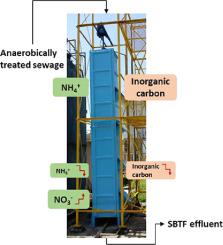Water Research ( IF 11.4 ) Pub Date : 2021-06-07 , DOI: 10.1016/j.watres.2021.117337 T Bressani-Ribeiro 1 , P G S Almeida 2 , C A L Chernicharo 3 , E I P Volcke 4

|
Anaerobic sewage treatment is a proven technology in warm climate regions, and sponge-bed trickling filters (SBTFs) are an important post-treatment technology to remove residual organic carbon and nitrogen. Even though SBTFs can achieve a reasonably good effluent quality, further process optimization is hampered by a lack of mechanistic understanding of the factors influencing nitrogen removal, notably when it comes to mainstream anaerobically treated sewage. In this study, the factors that control the performance of SBTFs following anaerobic (i.e., UASB) reactors for sewage treatment were investigated. A demo-scale SBTF fed with anaerobically pre-treated sewage was monitored for 300 days, showing a median nitrification efficiency of 79% and a median total nitrogen removal efficiency of 26%. Heterotrophic denitrification was limited by the low organic carbon content of the anaerobic effluent. It was demonstrated that nitrification was impaired by a lack of inorganic carbon rather than by alkalinity limitation. To properly describe inorganic carbon limitation in models, bicarbonate was added as a state variable and sigmoidal kinetics were applied. The resulting model was able to capture the overall long-term experimental behaviour. There was no nitrite accumulation, which indicated that nitrite oxidizing bacteria were little or less affected by the inorganic carbon limitation. Overall, this study indicated the vital role of influent characteristics and operating conditions concerning nitrogen conversions in SBTFs treating anaerobic effluent, thus facilitating further process optimization.
中文翻译:

用于厌氧污水主流处理的海绵床滴滤池氮转化过程中无机碳的限制
厌氧污水处理在温暖气候地区是一项成熟的技术,海绵床滴流过滤器 (SBTF) 是去除残留有机碳和氮的重要后处理技术。尽管 SBTF 可以实现相当好的出水质量,但由于缺乏对影响脱氮的因素的机械理解,特别是当涉及主流厌氧处理污水时,进一步的工艺优化受到阻碍。在这项研究中,研究了在厌氧(即 UASB)反应器处理污水后控制 SBTF 性能的因素。一个示范规模的 SBTF 供给厌氧预处理的污水被监测了 300 天,显示中值硝化效率为 79%,中值总氮去除效率为 26%。异养反硝化受到厌氧流出物中有机碳含量低的限制。结果表明,硝化作用受到无机碳的缺乏而不是碱度限制的影响。为了正确描述模型中的无机碳限制,添加了碳酸氢盐作为状态变量并应用了 S 形动力学。由此产生的模型能够捕捉整体的长期实验行为。没有亚硝酸盐积累,这表明亚硝酸盐氧化细菌受到无机碳限制的影响很小或很小。总体而言,该研究表明,在 SBTF 处理厌氧废水中,与氮转化相关的进水特性和操作条件的重要作用,从而促进了进一步的工艺优化。结果表明,硝化作用受到无机碳的缺乏而不是碱度限制的影响。为了正确描述模型中的无机碳限制,添加了碳酸氢盐作为状态变量并应用了 S 形动力学。由此产生的模型能够捕捉整体的长期实验行为。没有亚硝酸盐积累,这表明亚硝酸盐氧化细菌受到无机碳限制的影响很小或很小。总体而言,该研究表明,在 SBTF 处理厌氧废水中,与氮转化相关的进水特性和操作条件的重要作用,从而促进了进一步的工艺优化。结果表明,硝化作用受到无机碳的缺乏而不是碱度限制的影响。为了正确描述模型中的无机碳限制,添加了碳酸氢盐作为状态变量并应用了 S 形动力学。由此产生的模型能够捕捉整体的长期实验行为。没有亚硝酸盐积累,这表明亚硝酸盐氧化细菌受到无机碳限制的影响很小或很小。总体而言,该研究表明,在 SBTF 处理厌氧废水中,与氮转化相关的进水特性和操作条件的重要作用,从而促进了进一步的工艺优化。为了正确描述模型中的无机碳限制,添加了碳酸氢盐作为状态变量并应用了 S 形动力学。由此产生的模型能够捕捉整体的长期实验行为。没有亚硝酸盐积累,这表明亚硝酸盐氧化细菌受到无机碳限制的影响很小或很小。总体而言,该研究表明,在 SBTF 处理厌氧废水中,与氮转化相关的进水特性和操作条件的重要作用,从而促进了进一步的工艺优化。为了正确描述模型中的无机碳限制,添加了碳酸氢盐作为状态变量并应用了 S 形动力学。由此产生的模型能够捕捉整体的长期实验行为。没有亚硝酸盐积累,这表明亚硝酸盐氧化细菌受到无机碳限制的影响很小或很小。总体而言,该研究表明,在 SBTF 处理厌氧废水中,与氮转化相关的进水特性和操作条件的重要作用,从而促进了进一步的工艺优化。这表明亚硝酸盐氧化细菌很少或很少受到无机碳限制的影响。总体而言,该研究表明,在 SBTF 处理厌氧废水中,与氮转化相关的进水特性和操作条件的重要作用,从而促进了进一步的工艺优化。这表明亚硝酸盐氧化细菌很少或很少受到无机碳限制的影响。总体而言,该研究表明,在 SBTF 处理厌氧废水中,与氮转化相关的进水特性和操作条件的重要作用,从而促进了进一步的工艺优化。










































 京公网安备 11010802027423号
京公网安备 11010802027423号